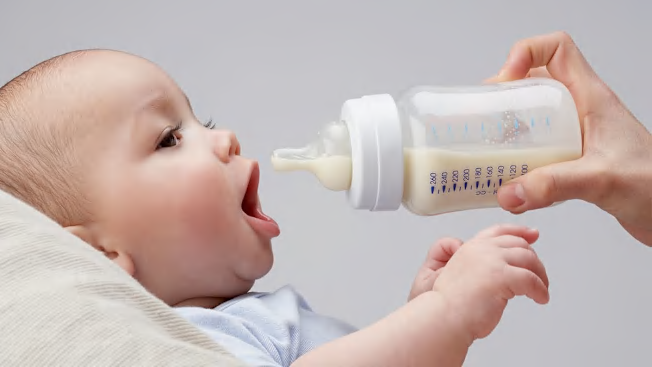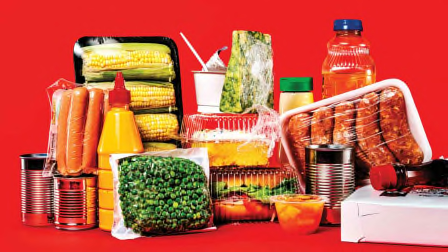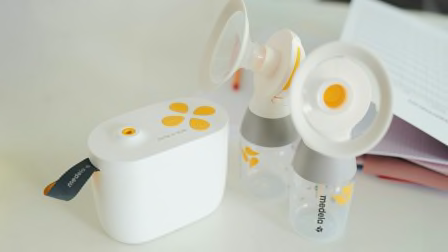How to Find the Right Baby Bottle Nipple Flow
Feeding issues? It might not be the baby, but the bottle. Parents and experts report wide variations in flow rates for some baby bottles.

Your baby is struggling with bottle feeding, and you’ve tried everything: You’ve sat the baby up, laid them down, changed the pacing. You may have even changed formulas trying to get your baby to eat more. But what if the trick to bottle-feeding success is finding the right nipple flow rate?
Baby bottles have evolved way beyond the classic, familiar design (emoji: bottle), and are now marketed with features ranging from “air removal” to “anti-colic” inserts. Many baby bottles offer a range of nipple flow rates targeted to different stages of infant development (“level 1” for 0 to 3 months, for instance). But for parents, it can be hard to know which nipple flow rate to choose. And for some babies, the wrong nipple flow rate may make bottle feeding challenging. A nipple flow that’s too slow may mean some babies struggle to get the nutrition they need. A flow that’s too fast, on the other hand, may “flood” them with an overwhelming amount of milk or formula, causing discomfort.
Struggling to Find the Right Bottle Nipple Flow? You’re Not Alone.
When Leny Gocheva, a mother from Swampscott, Mass., gave birth to her second child, she didn’t think twice about the bottle her family would use. They’d successfully used a Philips Avent bottle with their daughter 3 ½ years earlier, so sticking with that brand seemed like one less thing she needed to worry about with a newborn. However, feeding didn’t go as smoothly for her son.
“After our son came home from the hospital, he struggled to gain weight and frequently spit up, which constantly woke him up,” says Gocheva. After numerous doctor’s appointments, possible milk allergy diagnosis, and biweekly weigh-ins, her son still hadn’t gained the appropriate amount of weight, and spent a lot of the time fussy or crying.
“Nothing seemed to help,” says Gocheva. “After a few more sleepless nights and continued weight loss, the pediatrician had us switch to hypoallergenic formula to eliminate the possibility of an allergy and put him on reflux medication in case reflux was causing his discomfort and crying. We also scheduled appointments with two lactation consultants—at that point we were desperate and worried he was heading toward hospitalization and a failure-to-thrive diagnosis.”
Fortunately, their lactation consultant picked up on the possible culprit—a bottle nipple that was failing to dispense milk efficiently.
“After hearing this, my husband tested every single nipple we had at the house,” shares Gocheva. “With some of them, he couldn’t get any liquid out at all. He also found significant variability even within the same nipple size regarding how much fluid they dispense. It had never occurred to us that the issue could be with the nipples rather than our baby!”
After finding a nipple that did work for their child, Gocheva says it was like they had a new baby. Their son started gaining weight, and he spit up less often. He didn’t cry for hours at a time due to hunger, and she says they were even able to stop using the hypoallergenic formula and reflux medicine.
While Gocheva is thrilled that they were able to figure out the problem with the help of their lactation consultants, she says she still experiences rage and guilt.
“We couldn’t believe something like this could happen,” she says. “How could bottles/nipples not be more tightly regulated in the U.S.? I went back to Amazon and read some of the 1 star reviews and a bunch of other people had the same issue. It was a terrible feeling to realize that we had been inadvertently starving our newborn for weeks. At the end of the day, we were lucky that we figured it out relatively quickly and avoided hospitalization. Since then, we have heard stories that other parents are not that lucky.”
Gocheva is not the only parent reporting potential issues with the Philips Avent Natural Response nipple. Other issues similar to the one Gocheva and her family experienced can be found on the Consumer Product Safety Commission’s SaferProducts.gov, as well as the brand’s website and Facebook pages, and in online parent groups.
CR reached out to Philips Avent for comment about the challenges parents have reported with the Natural Response nipples. They responded, “At Philips, we know how important it is for parents to feel confident in feeding their newborn, which is why we continue to optimize our product offerings and communications based on consumer feedback. For example, we brought back our 2 oz First Flow Natural Response bottle at the end of last year by popular demand.” The company also suggests referring to updated nipple flow charts and additional information about flow rates on their website. “For parents who might have questions on flow rate, or which bottle might be best to use, we also offer additional information about bottle nipple transition and flow rates via Philips.com product pages and retailers, as a starting point.”
Philips is also not the only brand whose bottles have been the source of frustration for parents. Other major brands like Dr. Brown’s and Comotomo’s bottles have also been the subject of parent complaints. CR reached out to both companies for comment. Dr Brown’s said in a statement the company had no current plans to change its existing products or nipple flow information and that caregivers should consult their pediatricians with feeding questions. Comotomo did not respond to our request for comment.
What to Know About Nipple Flow
Different bottle nipple flow rates are designed to allow a baby to get milk out of the bottle quicker and easier, or a bit slower and with more effort. The trouble is, it can be hard to compare nipple flows across brands, and hard to know when to change levels as your baby grows. Some baby bottle brands, such as Dr. Brown’s, offer a wide range of nipples with different flow rates, while others, such as Philips Avent, offer baby bottle nipples marketed toward specific feeding issues, such as an “anti-colic” nipple, or a “natural response” nipple that claims to mimic breastfeeding.
“The most important thing for parents to know is that there is no industry standard for ‘slow.’ So slow for one brand is NOT the same as slow flow in another brand,” says Kira Kim, an international board-certified lactation consultant (IBCLC) in private practice in Massachusetts. “A great example is Comotomo. Their slow flow is about the same as Dr Brown’s 2, which is a medium flow nipple.”
“It’s much more common for babies to be fed with nipples that flow too fast rather than too slow,” Brill says. “However, there can be manufacturing inconsistencies that create defective bottle nipples with flow rates that are dangerously slow.” Brill suggests reaching out to an IBCLC for help finding a bottle nipple with the right flow. “The term ‘slow flow’ is meaningless, and we see some bottles labeled that way with much faster flow than others.”
Some baby bottles claim to imitate breastfeeding in their shape and flow rate, which can be especially appealing to parents who are combining breastfeeding and bottle feeding. For example, Emulait offers bottle nipples in varying colors that imitate different skin colors in order to closely resemble breastfeeding. Comotomo, Tommee Tippee Natural Start, and other brands also offer products that claim to imitate breastfeeding. But even these types of bottles can be challenging for some babies.
“Wide bottles with nipples that look like a breast are often problematic as the baby can’t compress the shoulder the way they would with a real breast, and so they wind up with a shallow latch,” Brill says. A lactation consultant can help with the transition between breastfeeding and bottle feeding to help you and your baby find the right bottle and nipple flow.
What this means for parents: Just as every baby is unique and has their own feeding preferences that take some time to master, finding the right bottle nipple flow may also involve trying a few different options to learn what works best for your baby. To make the trial-and-error process of finding the right bottle a bit simpler, some baby registries have started offering bottle sampler packs. For example, Babylist promotes “try-it kits,” including a set of five bottles for around $30.
Signs You’re Using the Right Baby Bottle Nipple Flow
If you’re not sure whether your baby is getting enough to eat from their bottle, don’t wait to bring up feeding issues with your pediatrician or IBCLC. In the meantime, here are some must-know tips from Brill and Kim:
- Notice if your baby is taking more than roughly 5 to 8 minutes per ounce, which may be a sign that the nipple flow is too slow. “There might be an issue either with the bottle or with the baby’s oral motor function,” says Kim.
- Likewise, notice signs that the nipple flow is too fast: “The flow should not overwhelm a baby, and there should not be any leaking, even with the bottle tipped up,” says Brill. Other signs of an overly fast nipple flow could include gulping, coughing, or hard swallowing, according to Nationwide Children’s Hospital.
- Kim suggests having your baby weighed regularly, such as every 2 weeks for the first 3 months, and then monthly, to watch for feeding issues. “I see a lot of issues where infants do relatively well for the first 6-8 weeks, get the all clear at their two-month appointment, and then fall off their curve between 2 and 4 months.” While regular weigh-ins might seem anxiety-producing for some parents, Kim stresses that the point is not to obsess over weight percentiles, “as long as they stay within a few percentile points of where they settled (usually around 2-3 weeks of age).”
- Watch for successful feeding signs, including “if a baby is stooling daily, having at least 5 heavy wet diapers, staying on their own growth curve, and is not fussy or spitting up profusely,” says Kim.
- “Pacing bottles by allowing the baby to take regular breaks when the bottle is in their mouth but tilted down helps keep them from eating too fast and allows them to better regulate their intake,” says Brill.




















